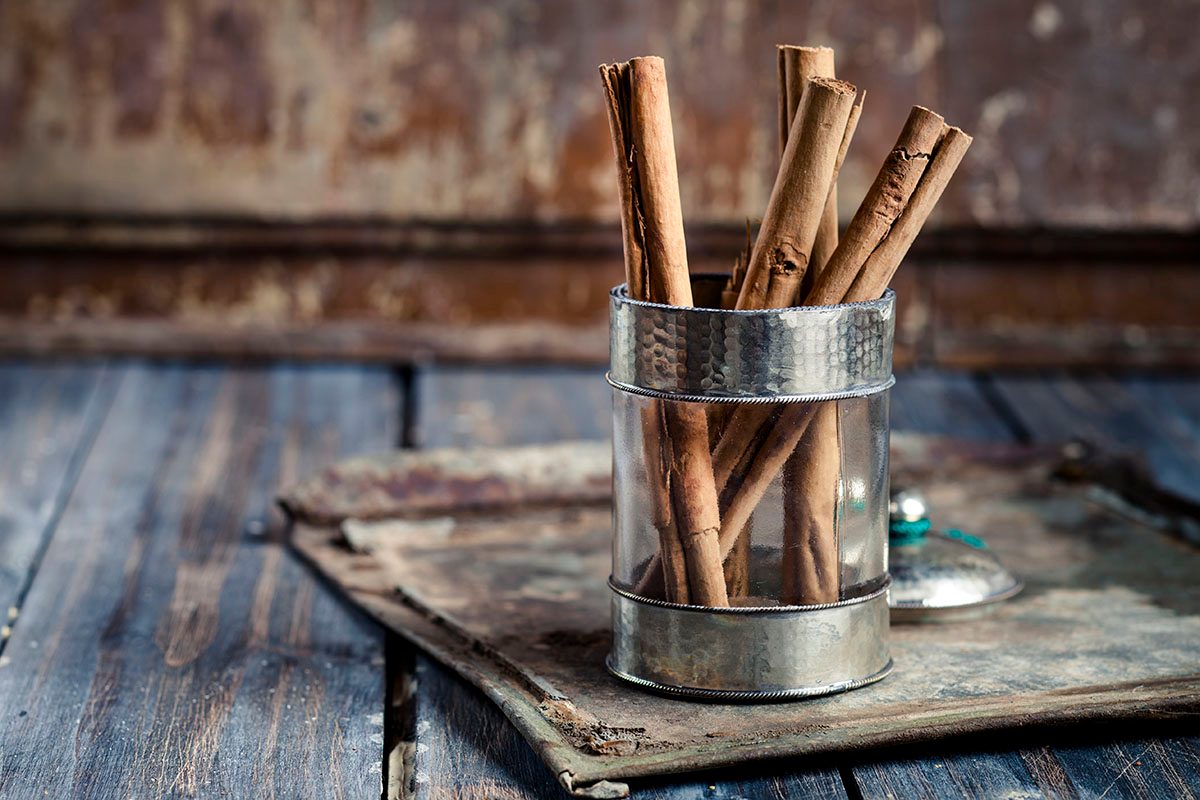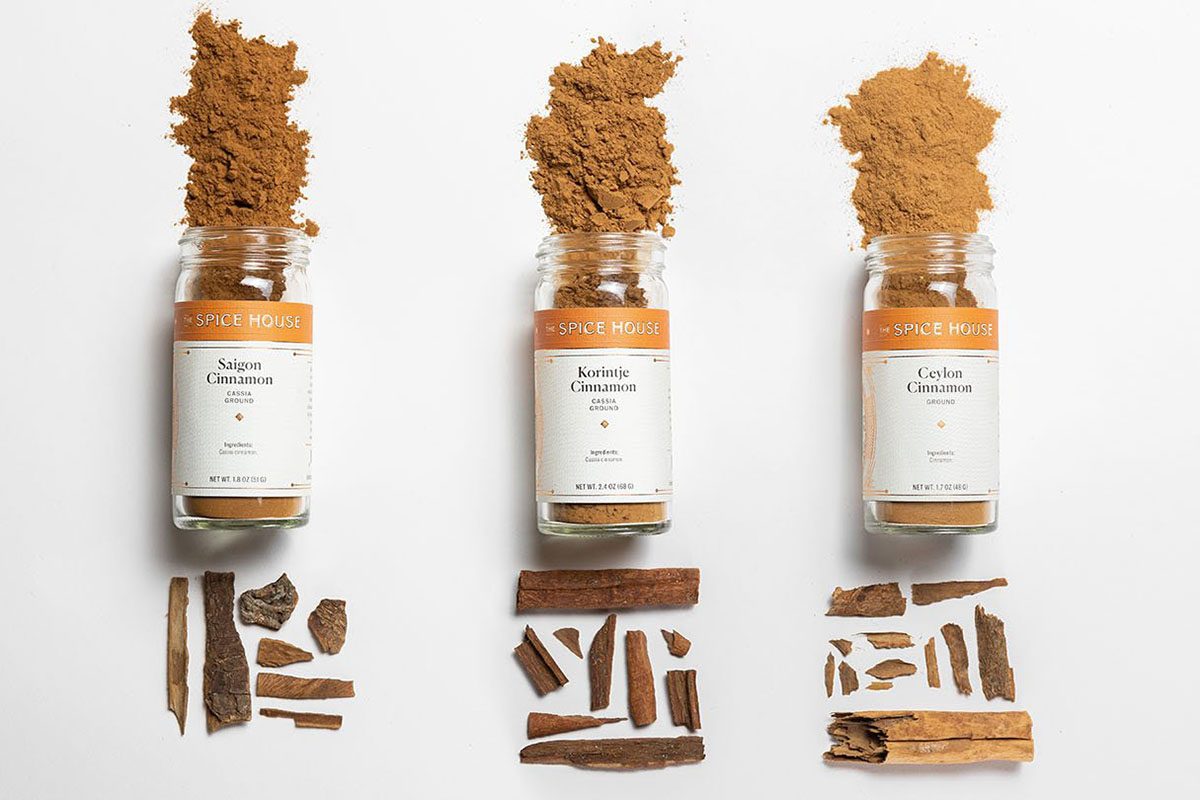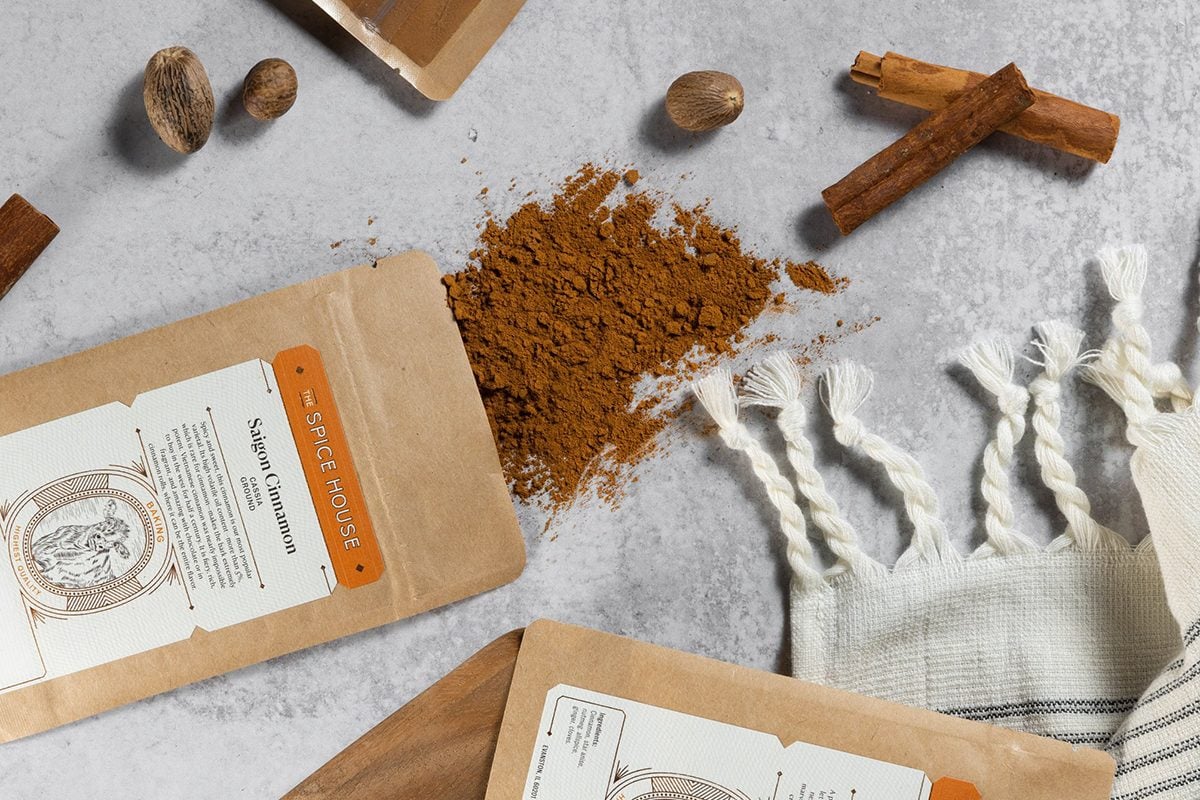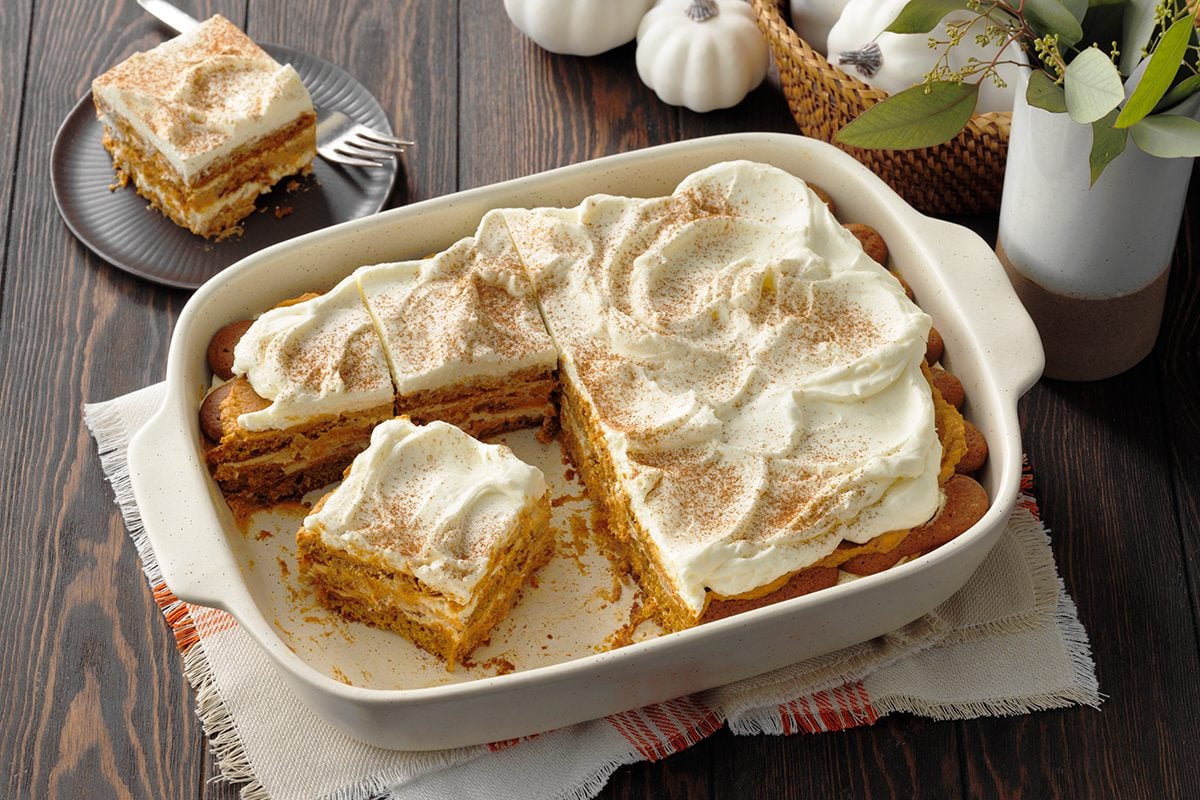When it comes to baking—fall and holiday baking especially—cinnamon is an essential part of favorite recipes. What would a homey cinnamon roll be without some warming spices? What would gingerbread be without the cinnamon to compliment the ginger? However, when we bakers head to our favorite spice shop, it can be hard to decide which types of cinnamon are really best for these bakes. Cassia? Ceylon? Ground cinnamon? Cinnamon sticks?
To get to the bottom of what makes these varieties different, I chatted with Alex Wilkens, operations manager at The Spice House, to find out all the details.
The Main Types of Cinnamon

There are two main types of cinnamon in the spice world: Ceylon and cassia. Both of these options come from the bark of trees.
Ceylon cinnamon is what people consider real cinnamon (its Latin name, Cinnamomum verum, means “true cinnamon”). According to Alex, Ceylon cinnamon is grown mostly in Sri Lanka (formerly called Ceylon) and is mild in flavor.
Cassia is also cinnamon even though it’s not botanically identical to Ceylon. Just because it doesn’t carry the same Latin name of “true cinnamon” doesn’t mean it’s any less of a cinnamon varietal or inferior in quality or flavor. Cassia cinnamons are a bit spicier. You can find a few different cassia varieties. There’s Saigon (sometimes called Vietnamese) cinnamon and Korintje (or Indonesian) cinnamon. Occasionally you may find Chinese versions as well (though it’s less common).
What Do Different Types of Cinnamon Taste Like?

Because these cinnamons are grown in different locales and are different species, their flavor profiles do vary. You may find you prefer the taste of one over the rest or that one type of cinnamon works really well in certain recipes. As long as your cinnamon is fresh and high quality, you can’t go wrong.
Ceylon Cinnamon
Ceylon cinnamon is the mildest of the cinnamon options. Alex describes it as “light, floral and fruity with none of the assertiveness that cassia brings.”
Because Ceylon cinnamon isn’t as strong as its cousins, it’s a wise choice if you’re a bit sensitive to spice or are just searching for a more mellow flavor in your bakes.
Ceylon is particularly popular in European and Mexican cooking, so when you’re checking out recipes with those origins, reach for a jar of Ceylon cinnamon. Alex recommends using this variety in horchata in particular.
Vietnamese/Saigon Cinnamon
If you’re looking for cinnamon with a serious kick, you want Vietnamese and Saigon cinnamon. Saigon cinnamon is assertive and “bold enough to mingle with other spicy flavors like ginger, nutmeg and cloves,” says Alex.
Because of its bold flavor and sweetness, Saigon cinnamon is a great option for baking as well. Alex suggests using it in cinnamon rolls. “It will be a game-changer,” he says. “Your family and friends will definitely notice.”
If you aren’t looking for such a powerful flavor but only have this type of cinnamon on hand, don’t abandon your recipe! Alex suggests using half of what the recipe calls for so you don’t get an overwhelming cinnamon flavor.
Indonesian/Korintje Cinnamon
“Not every recipe calls for tuning the cinnamon flavor up to 11,” according to Alex. That’s where you’ll want to grab Indonesian or Korintje cinnamon. This cassia cinnamon is a good middle ground between mild Ceylon and spicy Saigon.
If you’re only going to stock one cinnamon in your pantry, this is the option to grab because it’s so versatile.
When to Use Ground, Cracked and Cinnamon Sticks

In addition to the different flavors of cinnamon, you’ve also got to consider what form you want it to take. Ground cinnamon, cinnamon sticks (sometimes called quills) and cracked cinnamon “are an essential part of a well-stocked spice pantry,” according to Alex.
Ground Cinnamon
This is likely the form of cinnamon you’ve got in your spice rack at home, and it’s definitely the most frequently used for bakers. Use the ground cinnamon of your choice in baking recipes.
Cracked Cinnamon
Cracked cinnamon is fragmented pieces of cinnamon sticks. Alex recommends using this form to infuse cinnamon flavor into liquids. You can steep cracked cinnamon to create syrups and custards—just strain it out with a mesh sieve. You can also use these cinnamon bark pieces to create spiced cider and mulled wine.
Cinnamon Sticks
Cinnamon sticks last longer than their ground counterparts. Keeping a few sticks in the cupboard is a great insurance policy. According to Alex, “you won’t regret having a cinnamon stick or two stashed in the pantry and ready for action.” You can use a food processor or even a small coffee grinder with a blade (not the burr variety) to process it down into pieces or powder.
And don’t forget the power of a cinnamon stick garnish. As Alex says, “When it comes to hot cocoa, would you really ask someone you love to stir their favorite winter treat with a regular old spoon?”
Great Cinnamon Pairings

If you’re looking to add more cinnamon to your cooking and baking, look no further than natural cinnamon pairings. This spice is a great match for so many ingredients. Start with this cinnamon-pumpkin tiramisu and then explore these other options.
- Cinnamon + apple: Everyone knows what a fantastic combo this is. Tart apple and spicy cinnamon is a match made in heaven.
- Cinnamon + chiles: Alex recommends this pairing. Chiles are full of heat and cinnamon gives off some warmth as well. Next time you see chiles in a recipe, try a dash of cinnamon, too.
- Cinnamon + chocolate: Cayenne and chocolate get a lot of attention, but for those craving just a smidge of heat, cinnamon makes a great cocoa companion.
- Cinnamon + coffee: Think about your favorite cafe’s coffee bar. Chances are there’s a jar of cinnamon sitting next to the creamer. That’s because cinnamon and coffee are a natural pairing. Sprinkle it on your next latte or try this homemade cinnamon mocha.
- Cinnamon + pumpkin: Cinnamon is a major player in pumpkin spice, and it’s what gives your pumpkin pie personality! Add a teaspoon (or two) of cinnamon to your favorite pumpkin recipes.
- Cinnamon + warming spices: Bakers, you’re familiar with how well cinnamon works with all sorts of warming spices like ginger, cloves, nutmeg and even star anise. Anytime you see these spices in a recipe, know that cinnamon is also welcome at the party.
With so many uses, you’ll definitely want to stock your pantry with all kinds of cinnamons. I just snagged this cinnamon variety set and it’s been fun experimenting. Give it a go yourself!

Honey Cinnamon Rollups
This cinnamony treat reminds me of baklava, but with only a few easy ingredients, it's a fraction of the work. My Aunt Adele shared the recipe with me, and I think of her whenever I make it. —Sue Falk, Warren, Michigan
Caramel-Pecan Cinnamon Rolls
These irresistible rolls are perfect as an Easter brunch idea! - Louis Jacobsen, Dallas, Wisconsin
Hand-Held Apple Pies
When I was in high school, my best friend's mother baked this mini apple pie recipe every year. I was thrilled when she shared it with me—I finally felt like an adult! —Katie Ferrier, Houston, Texas
Sweet Potato Cinnamon Bread
My family loves quick breads. This one is moist and spicy. If you don't have mini loaf pans it works just as well in regular size pans. —Nancy Foust, Stoneboro, Pennsylvania
Snickerdoodles
The history of this whimsically named treat is widely disputed, but the popularity of this classic cinnamon-sugar-coated cookie is undeniable! —Taste of Home Test Kitchen
Cinnamon Nut Bars
Classic bar meets good-for-you ingredients in this updated recipe. If you have the patience, after the bars are cool, store them in a tin for a day to allow the flavors to meld...I think they taste even better the next day.— Heidi Lindsey, Prairie du Sac, Wisconsin
German Apple Strudel
This gorgeous strudel has just what you crave this time of year: thin layers of flaky crust and lots of juicy apples. —Darlene Brenden, Salem, Oregon
Giant Cinnamon Roll
This must-try cinnamon roll is all about the pillowy texture, the sweet spices and the homemade caramel drizzle. —Leah Rekau, Taste of Home food stylist
Mexican Cinnamon Cookies
My extended family shares a meal every Sunday. The aunts and uncles take turns bringing everything from main dishes to desserts like this traditional Mexican cinnamon cookie called reganadas. —Adan Franco, Milwaukee, Wisconsin
Cinnamon Swirl Apple Pie
Apples and cinnamon go together like peanut butter and jelly. It's no wonder my kids love this scrumptious cinnamon roll apple pie recipe that uses a shortcut ingredient to make a deliciously fun crust. —Barbara Curran, Lebanon, New Jersey
Cinnamon Apple Cider Monkey Bread
I use the cold-weather staple apple cider—plus apples and more cinnamon—to turn plain cinnamon rolls into monkey bread. My boys love the sticky sweetness. —Kelly Walsh, Aviston, Illinois
Chai Tea Sandwich Cookies
You’ll love these cookies filled with a dreamy chai-infused ganache. They’re perfect after a meal, with a cup of tea, as a breakfast treat—or anytime at all. —Lauren Knoelke, Des Moines, Iowa
Pumpkin Cake with Whipped Cinnamon Frosting
My mom made this for me, and one bite can completely take me back to my childhood. You can easily convert it into a great carrot cake recipe: just use grated carrots in place of pumpkin and add raisins. —Melissa Pelkey Hass, Waleska, Georgia
Toffee Apple Cinnamon Buns
This recipe was my dad’s favorite growing up. He would sit and watch his mom sprinkle the dough with sweet filling, carefully roll it up and cut it into rounds. The anticipation waiting for them to come out of the oven was almost more than he could bear. —Jeanne Holt, Mendota Heights, Minnesota
Baked Elephant Ears
My mother-in-law handed down this recipe from her mother. They’re a special treat—even better, I think, than those at a carnival or festival. And (shh!) they're baked, not fried. —Delores Baeten, Downers Grove, Illinois
Spicy Applesauce Cake
This picnic-perfect cake travels and slices very well. With chocolate chips, walnuts and raisins, it's a real crowd pleaser. —Marian Platt, Sequim, Washington
Cinnamon-Pear Rustic Tart
I was lucky enough to spend the holidays with my husband's family in Montana. I loved the rustic simplicity of each dish we tasted, especially this rustic pear tart my mother-in-law made. —Leah Waldo, Jamaica Plain, Massachusetts
French Toast Cookies
I created these soft, sparkly cookies because my sister loves cinnamon French toast covered in maple syrup. In the case of these cookies, bigger is definitely better! I like to use white whole wheat flour, but any whole wheat flour will work.—Mary Shenk, Dekalb, Illinois
Cinnamon-Spiced Pumpkin Flan
I love pumpkin and decided to add it to a traditional recipe for flan. It's an interesting change of pace from the usual holiday pie. —Alisha Rodrigues, Tetonia, Idaho
Mexican Crinkle Cookies
When it’s baking time, my family lobbies for these Mexican crinkle cookies. You can replace 1 oz. unsweetened chocolate with 3 Tbsp. cocoa powder plus 1 Tbsp. shortening, butter or oil.—Kim Kenyon, Greenwood, Missouri
Cappuccino Cinnamon Rolls
Distinctive coffee flavor accents the filling of these ooey, gooey rolls. The glaze goes on while they are still warm—they won’t last long!. —Sherri Cox, Lucasville, Ohio
Cinnamon Twists
These delightful golden twists are perfect for a spring brunch or lunch. The brown sugar and cinnamon give them a delicate spicy flavor. It's a good thing the recipe makes a big batch, because people can rarely eat just one. —Janet Mooberry, Peoria, Illinois
Cinnamon Swirl Bread
Your family will be impressed with the soft texture and appealing swirls of cinnamon in these lovely breakfast loaves. —Diane Armstrong, Elm Grove, Wisconsin
Orange-Cinnamon Chocolate Chip Cookies
I developed this recipe after years of searching for a chocolate chip cookie that would stand out from all others. Orange and cinnamon are tasty additions. —Daniel Kaepp, Coldwater, Michigan
Cinnamon-Walnut Sticky Buns
The sweet honey-walnut topping and tender texture make these sticky rolls a surefire crowd-pleaser. —Debbie Broeker, Rocky Mount, Missouri
Cinnamon Sugar Cookies
My mom always had these cookies on hand. They're so good with a cup of hot chocolate, coffee or milk. —Leah Costigan, Otto, North Carolina
Cinnamon Fruit Biscuits
Because these sweet treats are so easy, I'm almost embarrassed when people ask me for the recipe. They're a snap to make with refrigerated buttermilk biscuits, sugar, cinnamon and your favorite fruit preserves. —Ione Burham, Washington, Iowa
Can't-Eat-Just-One Cinnamon Rolls
My cinnamon rolls have been known to vanish quickly. Once I dropped off a dozen rolls for my brothers, and they emptied the pan in 10 minutes. —Regina Farmwald, West Farmington, Ohio
Cinnamon-Sugar Apple Pie
Apple pie baked in a cast iron skillet is a real stunner. This beauty, with its flaky, tender crust, also works in a 9-inch deep-dish pie plate. —Renee Schettler Rossi, New York, New York
Snickerdoodle Blondie Bars
When asked to bring a dessert for my boys' football team to share, I whipped up these unique blondies and was instantly named "the greatest mom" by all. —Valonda Seward, Coarsegold, California
Bite-Size Cinnamon Roll Cookies
If you love cinnamon rolls and spiced cookies, make a bite-sized version that combines the best of both worlds. Genius! — Jasmine Sheth, New York, New York
Cinnamon Raisin Quick Bread
Cinnamon and raisins bring heartwarming flavor to this mildly sweet bread. It's ideal for an on-the-go breakfast or a quick snack before dinner. —Flo Burtnett, Gage, Oklahoma
Caramel Snickerdoodle Bars
What did I do when I couldn’t decide between two of my favorite desserts? I combined them! This snickerdoodle-blondie hybrid proved even better with caramel, always a favorite ingredient. —Niki Plourde, Gardner, Massachusetts
Pretty Pumpkin Cinnamon Buns
I make sticky buns and cinnamon rolls quite often because my husband loves them. One day I had some fresh pumpkin on hand and decided to try pumpkin cinnamon buns. We loved the results! —Glenda Joseph, Chambersburg, Pennsylvania
Cinnamon Doughnut Muffins
Back when my children were youngsters, they loved these doughnut muffins as after-school treats or with Sunday brunch. —Sharon Pullen, Alvinston, Ontario
Cinnamon Brownies
For Christmas one year, a friend gave us a pan of these delicious brownies. Before I figured out their secret was cinnamon, half the pan was already gone! —Gail Mehle, Rock Springs, Wyoming
Snickerdoodle Crisps
This classic cookie from New England can be made two ways: soft or crunchy. My happy version with cinnamon, ginger and nutmeg is crispy to perfection. —Jenni Sharp, Milwaukee, Wisconsin
Mom's Chocolate Bread
My mom made this divine chocolaty bread only for holidays or special requests, but it makes any old morning even better. I always think of our family when I smell it baking. —Rachel Rhodes, Bedford, Pennsylvania
Cinnamon Chip Chai-Spiced Snickerdoodles
I love cinnamon chips, and this is an intriguing way to use them. Make sure to stock up on them during the holiday season so you have plenty to last during the year. —Marietta Slater, Justin, Texas
Pumpkin Spice Cupcakes
I make these flavorful pumpkin cupcakes each Halloween, but they're wonderful year-round. —Amber Butzer, Gladstone, Oregon
Cinnamon Apple Cheesecake
An attractive topping of cinnamon-spiced apple slices and a homemade oat-and-walnut crust make this creamy dessert a definite showstopper. —Emily Ann Young, Edmond, Oklahoma
Cinnamon Chocolate Chip Rolls
I started adding chocolate chips to my cinnamon rolls because several children didn't like the raisins in them. The chocolate and cinnamon are a fun flavor combination. My family loves them, and so does my Sunday school class. —Patty Wynn, Pardeevlle, Wisconsin
Cinnamon Sugar Crackle Cookies
I get lots of compliments on these crunchy cookies. They're always part of my Christmas cookie platter. —Sarah Miller, Wauconda, Washington
Honey Cinnamon Bars
My Aunt Ellie gave us the recipe for these sweet bar cookies with cinnamon and walnuts. Drizzle with icing, and serve with coffee or tea. —Diane Myers, Star, Idaho
Spiced Toffee Cookies
I bake these cookies for family gatherings because my crowd likes cookies thin and chewy with a crispy exterior. The toffee bits make a happy surprise.—Gloria Bradley, Naperville, Illinois
Pistachio Palmiers
My family loves palmiers from the bakery, so I created my own recipe. These have a Mideastern twist with the addition of rosewater, honey and a touch of cardamom. They are light and crisp, and a special treat for the holidays. —Deborah Hinojosa, Saratoga, California
Citrus Gingerbread Cookies
Orange and lemon zest give gingerbread cutouts a refreshing twist. Brushing a honey glaze over the top adds a subtle shine and an extra touch of sweetness. —Monique Hooker, DeSoto, Wisconsin
Coffee Cake Muffin Mix
Our local home-school group has an annual Christmas craft breakfast. Forty children signed up to come to my table and make this mix. It was so rewarding to see their excitement as they created a special gift to give. —Tamera Serafin, New Windsor, Maryland
Overnight Cinnamon Rolls
I like to try different fun fillings in these soft rolls, and each one is packed with cinnamon flavor. They are definitely worth the overnight wait. —Chris O'Connell, San Antonio, Texas
Cinnamon Crescents
I've had the recipe for these crispy cinnamon-sugar roll-ups for years. They're one of my family's favorites and so easy to make. We enjoy them at breakfast with a cup of coffee. —Emily Engel, Quill Lake, SaskatchewanThe post Types of Cinnamon You Need for Baking and Beyond appeared first on Taste of Home.
Lisa Kaminski